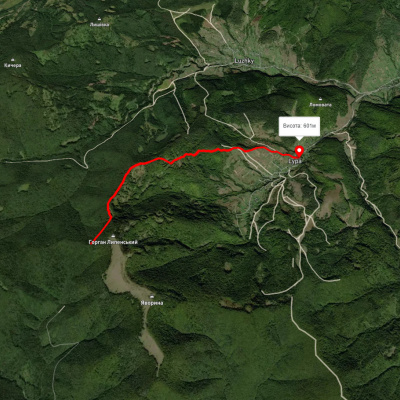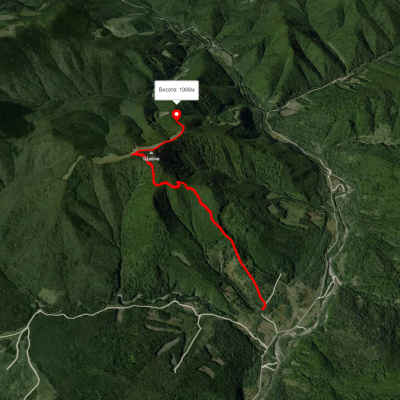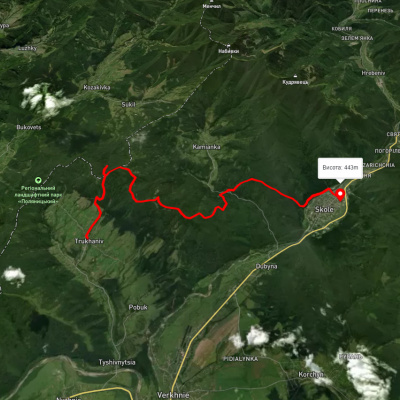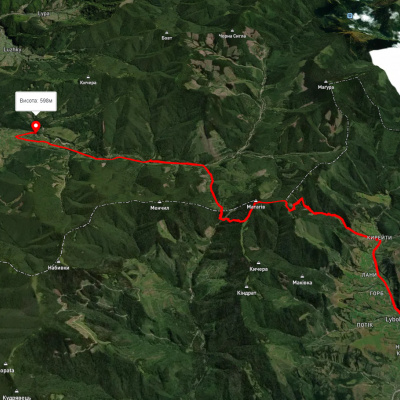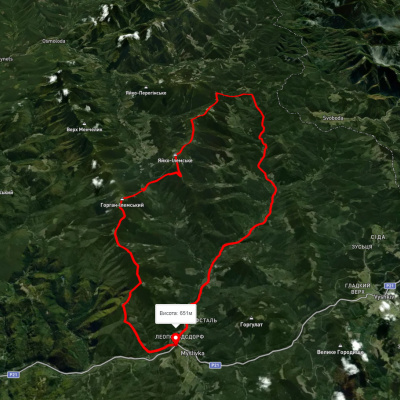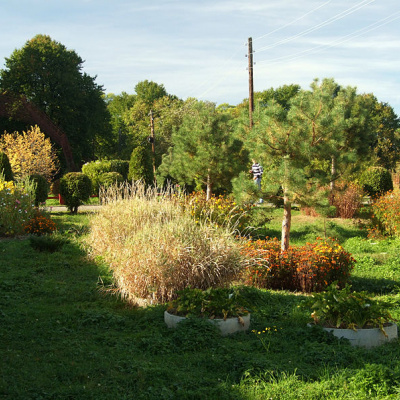Arboretum Park is one of the oldest parks in Ivano-Frankivsk region. It is located in the Ivano-Frankivsk region, in the
city of Bolekhiv, at 14 Zamkova Street (between Yevhen Konovalets and Sichovykh Striltsiv streets, near the buildings of the Forestry College). It was founded by enthusiastic foresters in 1840-1850 and covers an area of 3 hectares.
The history of the Park Arboretum landscape art monument dates back to the mid-nineteenth century, when the Directorate of Forests and State Property of Galicia was located in Bolekhiv. At that time, near the administrative building, foresters and enthusiasts planted young trees brought from Austrian, German, and Italian nurseries. In addition, they grew material from seeds imported from France and North America and experimented with other plantings. As a result of these circumstances, a botanical collection was formed, which included more than two hundred species of trees covering an area of more than 6 hectares.
However, at the end of the 19th century, the Forestry Directorate was transferred to Lviv, and the buildings and park were used by the Lower Forest School (later the State School for Foresters), which was established in 1883. It became the third forestry school in Austria-Hungary and the first of the lower (one-year) forestry schools on the then Ukrainian territory. This situation had an even more positive impact on the heyday of the arboretum, as employees and students became even more enthusiastic about breeding experiments. The young experimenters increased the collection of species and garden forms from the Quercus genus, and grew such exotic species at that time Broadleaf larch (Larix eurolepis), Japanese larch (Larix japonica), Rumelian pine (Pinus reis), western thuja (Thuja occidentalis), Canadian thuja (Tsuga canadensis), and Loveson's cypress (Chamaecyparis lavso-niana), Gleditschia triacanthos, Amur velvet (Phellodendron amurense), green linden (Tilia euchlora), white carya (Sagua alba), fringed carya (Sagua laciniosa Lour) and other numerous species.
Since the State School for Foresters gained prestige and popularity in the district, the Arboretumhas also gained popularity , becoming one of the examples of dendrological heritage of Prykarpattia.
Abandonment of the park during the Soviet era
The heyday of the dendro-park ended with the arrival of the Soviets in Western Ukraine. Soon, the park, as a symbol of the past "class evils," began to be an eyesore for the new rulers, and its ordeal (transfer from one department to another) began. Only the war (World War II) stopped the looting, possibly because the forestry school was restored. But after the war ended and the school was closed, the park was divided into several parts.
- One part, 3 hectares in area, was allocated to the city park. This is the largest part of the park, but the variety of dendrological forms is almost lost here. Only a few old trees of Carpathian cedar (Pinus cembra), Weymouth pine (Pinus strobus), and small-leaved linden (Tilia cordata) have survived. In Soviet times, the entire territory of the city park was planted with rows of black poplar (Populus nigra), hornbeam (Carpinus betulus), and other low-value species. A lot of accidental self-seeding has occurred. Now the territory requires serious intervention from both gardening and park construction specialists and the local utility company. Decision No. 264 of the Executive Committee of the Ivano-Frankivsk Regional Council of July 7, 1972, granted Bolekhiv City Park the status of an Arboretum monument of landscape art of local importance.
- The second part of the old arboretum, located between the city park and the territory of the forestry college, was used for individual construction. This is the territory that today belongs to the city's Department of Urban Development and the courtyards around the houses on Sukhoi Street built after World War II.
- The third part of the arboretum, with an area of 0.7 hectares, belonged to a military unit located in the premises of the State School for Foresters from 1944 to 1997. It was not maintained, but the closed regime of the military territory allowed preserving many species of trees. This is the most valuable part of the old park. Today it belongs to the territory of the Carpathian Forestry College.
The park's present (since Independence)
In the first years of Ukraine's independence, no one got their hands on the park (due to the difficult economic situation and interagency tug-of-war). Only when the local authorities came to a common opinion on the future prospects of Arboretum was it determined who would become the park's guardian. Thus, in 1998, the former premises of the State School for Foresters (which at that time belonged to the military) were transferred to the Forestry College, and the creation of the Arboretum began on the territory of this former military unit, which covers 4.5 hectares. The structure of the park includes a part of the old park around the building of the State School for Foresters (0.7 hectares), as well as the territory of the college, where some 150-year-old oaks and lindens grow, an orchard and a newly created ornamental nursery.
Today, the park protects old trees: European larch (Larix decidua L.), Polish larch (Larix polonica), mountain pine (Pinus mughus), scots pine (Pinus silvestris), and common ash (Fraxinus excelsior), white acacia (Robinia pseudoacacia), warty birch (Betula veucosa), forest beech (Fagus silvatilca), rough elm (Ulmus scabra), bitter chestnut (Aesculus hippocastanum), common oak (Quercus robur), northern oak (Quercus rubra), sharp-leaved maple (Acer platanoides), field maple (Acer campestre), sycamore maple (Acer pseudoplata-nus), small-leaved linden (Tilia cordata), broad-leaved linden (Tilia platyphyllos), European cedar (Pinus cembra).
In addition to the ornamental species typical of our latitudes, the park offers some interesting exotics. For example, near the entrance to the college, there is a slender tree of the Lovson cypress (Chamaecyparis lavsoniana), which originates from North America. The park is home to another North American tree that is rare in our area, the white carya (Carya ovata), which is over 80 years old. Due to the very low germination rate of its seeds in Ukraine, white carya is found only rarely in the parks of Kyiv, Lviv, Uzhhorod, and Chernivtsi. The original foliage and fruits of the majestic black walnut (Juglans nigra) immediately catch the eye. Its fruits look similar to walnuts, but have a very rough and tough shell, and the seeds are very small. The leaves are not pinnate, but up to 50 cm long with 15-20 oblong-lanceolate leaves. The leaves are pointed at the top, finely toothed along the edges, light green above, glabrous, slightly pubescent below, 6-12 cm long and 2-4 cm wide. In autumn, the leaves turn bright yellow. This form of walnut is used in landscaping and forest plantations. The wood itself is dark brown heartwood and is valued no less than the wood of the Greek walnut. Black walnut is more frost-resistant, demanding on soil fertility and moisture, while being more light-loving and fast-growing.
A curiosity in the central part of the park is a low Amur velvet tree, or Amur cork tree (Phello-dendron amurense), which attracts attention with its double trunk. The natural habitat of the cork tree is the Far East and northern China. At a young age, the trunk is covered with light gray velvety bark (hence the name - velvet). In older trees, a rough (up to 7 cm) layer of cracked cork bark is formed. The species is phytoncidal - leaves, young shoots, bark, fruits and seeds have a strong terpentine odor. In autumn, visitors to the park note that it is decorated with red forms of forest beech and sharp-leaved maple.
Since the arboretum was handed over to the College of Forestry, Arboretum has been experiencing its second youth. Since the very first years, the college staff and students have planted thousands of specimens of trees and shrubs. Every spring and fall, students plant trees and shrubs in their own arboretum. Seeds and saplings are imported from Germany, Austria, and Poland; foresters from Prykarpattia, Lviv, and Ternopil regions actively help to nurture the park.
Today, the park is home to young trees of many varieties of magnolia, thuja, juniper, yew, pine, sequoia, eucalyptus, gingo, Amur boxwood, tulip, vinegar trees, catalpa, and many others. The species composition of the arboretum is being actively expanded, small architectural forms are being built, and scientific research is underway.
